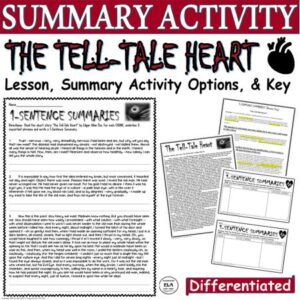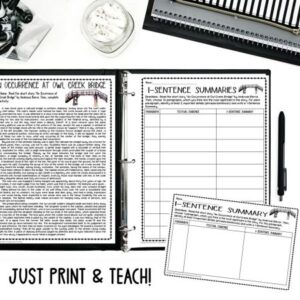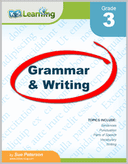Paraphrasing and Summarizing Exercises with Answers

Paraphrasing and Summarizing are two skills that are highly useful for writers. With these two techniques, writers can get help creating their content and providing it to their readers in an easy-to-peruse way.
However, if you happen to be new to the field of writing, you could be a little unaware and untrained in both these skills. But don’t worry. Everyone starts out as a beginner.
In this post, we’re going to be looking at some paraphrasing and summarizing exercises along with their answers and explanations. By following along, you’ll get a good idea about how you can use these techniques in your own capacity.
Let’s begin!

What is Paraphrasing and Summarizing?
Before we get to the exercises, let’s digress a little and understand what paraphrasing and summarization actually are.
Let’s start with paraphrasing.
Paraphrasing is the process in which a particular piece of content is reworded and rephrased in such a way that it looks different from its original version but it has the same meaning and context.
A simple example of paraphrasing would be to change “John likes his cat” to “John adores his feline pet”. Paraphrasing can be as slight as merely changing some words in the text, or it can be as drastic as fully changing the tone, structure, order, and words of the content.
On the other hand, Summarizing is the process in which a piece of content is shrunk and shortened to about one-tenth of its original size. In this shortened version, the main idea and concept of the content is provided.
Summarization is usually used by authors and writers when they want to give a brief outline of a book or article to their readers.
Now that we’ve looked at the definitions of both, let’s move ahead to look at some exercises.
Paraphrasing Exercises (with Answers)
The main purpose of providing these exercises along with their answers is to help you understand what these techniques look like when they are implemented. Since we have explained their core definition above, you can try and work along the exercises to improve your skills a little as well.
Related: Difference Between Paraphrasing And Rephrasing
Paraphrasing Exercise # 1:
Here is a sample paragraph that we will be paraphrasing as an exercise. We’ll write the paragraph alone first, and then provide the answer after a brief explanation.
Sample Paragraph:
"John could not find the butter in his fridge. He went to buy some from the store. On coming back, he saw his cat sitting on the floor, smacking its lips. There was some yellow stuff smeared all around its face. Thus, John solved the mystery of the missing butter."
So, as we mentioned earlier, paraphrasing can be done simply and sparingly, or it can be done drastically.
One of the primary and basic ways of paraphrasing is to simply change some words in the provided content with their synonyms. This is, we reiterate, a very basic level of paraphrasing, and it is often very easy to see through it.
So, for this first exercise, we are going to be doing only that level of paraphrasing as a way to illustrate how it looks like.
Here is what the above paragraph looks like when paraphrased:
Paraphrased Paragraph:
"John could not locate the butter in the refrigerator. He went to purchase some from the shop. On coming back, he observed his cat sitting on the ground, licking its lips. There was some yellow material smeared all around its face. Hence, John solved the mystery of the missing butter."
While we are on this discussion, it will also be salubrious to understand that when changing words with their synonyms for the purpose of paraphrasing, you have to be careful that you pick those that don’t mess up the context and intent of the lines.
Paraphrasing Exercise # 2:
Moving on, let’s look at another paraphrasing exercise. Here is the paragraph that we will be using for this one:
"John’s cat got lost in the forest. He went looking for it in the night time. He heard some movement in one of the bushes. He put his hand in and felt the fur. He pulled the thing out, thinking it to be his cat. After coming home, he realized it was an angry raccoon."
We mentioned in the last exercise that the basic level of paraphrasing is to change some of the words in the given text with their synonyms. And we also mentioned how that sort of paraphrasing can be easily detected.
So, for writers who want to paraphrase something in such a way that it does not resemble its original form a lot, there’s a step further that they can go, and that is to change the sentence structures + phrases.
Essentially, by changing the phrases used in the content as well as the arrangement of the sentences, the overall look of the paraphrased piece looks very different. If someone wants to go even ahead of that, they can shuffle the sentence order as well.
Considering this type of ‘extensive’ paraphrasing, here is the answer to the paragraph given above:
"John’s cat went missing in the forest. He went to search for it when it was dark. He discerned some movement in the hedge. After putting his hand inside it, he felt some fur. Thinking that it was his cat, he pulled the animal out. It was only after coming home that he realized that it was a frustrated raccoon."
Read more: How And Why to Paraphrase Your Content?
Summarizing Exercises (with Answers)
Now that we have looked at the paraphrasing exercises, let’s move on to look at some for summarizing.
Just as we’ve looked at two types of paraphrasing above, we’ll also look at two different types of summarizing.
Actually, it’ll be better if we explain those two types before getting to the exercises.
Basically, there are two types of summaries . One of them is called extractive and the other is called abstractive .
In extractive summarization, the summary of a piece of content is generated merely by taking out some sentences from it and joining them together. This is usually the type of summaries that you get from automated tools.
When extractive summaries are created, there is no effort to understand the actual meaning and context of the text. Rather, the purpose is only to take some lines from it and join them together in such a way that they make sense.
On the other hand, abstractive summaries are those that are written using a completely new and different set of words, phrases and sentences than the content (that is being summarized). As opposed to extractive summarization, abstractive summarization involves understanding the meaning and context of the text, and then creating a completely new summary that features all those concepts and ideas.
Summarizing Exercise # 1 (Extractive)
In order to demonstrate and explain extractive summarization, we’re going to first write a paragraph here and then provide its summary afterwards:
Sample paragraph:
"John’s car broke down. He stopped by the road side and screamed at people to stop and help him. But no one stopped for him. He continued howling and howling for hours. People kept driving by. After getting tired, he picked up a sheet and wrapped it around himself. Then, he started spinning on his spot. He grew dizzy. He kept spinning and spinning until he fell asleep."
Now, since we have to use the “extractive” summarization technique here, we’ll create the summary using the lines and sentences used in the content itself.
"John’s car broke down. But no one stopped for him. Then, he started spinning on the spot. He kept spinning and spinning until he fell asleep."
Summarizing Exercise # 2 (Abstractive)
For this exercise, we will use the same para that we did above. However, the technique used for the summarization will be different.
Since we will be using the abstractive technique here, the summary will be created using different words and phrases as the original.
"John’s vehicle went phut. But, no one stopped their car to help him. After he was tired, he made himself dizzy by spinning and then went to sleep."
So, that’s about it.
If you were a little confused about paraphrasing and summarization techniques, hopefully you’re a little more confident about them now.
These skills can come in handy for writers in a lot of different situations. If you don’t have the hang of them already, you should try and get it as quick as you can.

Worksheets on Summarizing Made Easy…
Oct 1, 2022
Long story, short… that’s exactly what a summary is! But how often does someone who uses that statement actually make their story short?! Whether in school or in life beyond the classroom, summarizing is a skill that needs practice, repeated practice. Writing a summary is a skill that needs to be honed. It should be taught yearly, not just as a refresher but as though it’s a brand new task. Certainly, students will have a background in the skill as they have repeated exposure through worksheets on summarizing, but treating it as new means you can shift to more challenging texts and more challenging strategies for summarizing too!
If you’re just starting with summary skills, then consider this series of reading comprehension passages . Each of these worksheets on summarizing focuses on finding the central idea in either an informational or narrative text. Being able to find a central idea is a foundational skill, particularly if summarizing a short story.
Building on that skill in the initial stages will ensure students in classes all the way through AP Lang are able to be even more succinct with their summaries. To practice that, you could use this lesson that focuses on writing one-sentence summaries of a speech about child labor . These worksheets on summaries are ideal because the text is already in chunks to help differentiate for your students!
Need help with Test Prep? Check out this FREE Pack of 3 Test Prep Activities to help students achieve success on standardized tests!

Table of Contents
Significance of Worksheets on Summarizing
As a skill, summarizing is integral to the development of critical thinking. With strategies for summarizing, students can sort important information from irrelevant information. And, with well-scaffolded worksheets on summarizing, students can analyze a variety of texts. They can then integrate this new information with their own background knowledge. In turn, this can better inform their thinking on a variety of topics from short stories to world issues featured in the news.
Summarizing is also relevant in life beyond the classroom. When applying for jobs, students will be asked to summarize their experience, so they’ll need to review their whole work history in order to pick out the most relevant and important information. If it’s in a job interview, this will need to be done quickly and effectively. A solid background in summarizing throughout high school means that this skill is finely honed and ready to be used at the minute!
Want help with guided reading activities you can use with worksheets on summarizing? Click below!

Difference between paraphrasing and worksheets on summarizing
Paraphrasing means rewording what someone else has written or said using your own words, usually to the same level of detail. In contrast, summarizing highlights the central idea without the inclusion of a lot of detail unless it supports the main idea.
Take a look at these examples using the opening paragraph of Poe’s “The Tell-Tale Heart” :
“True! — nervous — very, very dreadfully nervous I had been and am; but why will you say that I am mad? The disease had sharpened my senses — not destroyed — not dulled them. Above all was the sense of hearing acute. I heard all things in the heaven and in the earth. I heard many things in hell. How, then, am I mad? Hearken! and observe how healthily — how calmly I can tell you the whole story.”
Paraphrased: I was very anxious but I was not mad. In fact, my five senses were sharp, especially my hearing. I could hear everything both figurative and literal. But listen, I have a story to tell you and I will do it calmly and thoroughly.
Summarized: The speaker is anxious but has a story to tell.
In each instance, the paragraph is explained but note the difference in the level of detail. The paraphrase takes the seven sentences and re-tells the story in only slightly fewer sentences. The strategy for summarizing meanwhile is to boil down as much as possible to get to the central idea or, dare I say, the heart of the paragraph!
Get the worksheets on summarizing “The Tell-Tale Heart” by clicking below!

What You Can Summarize…
Any number of texts can be used for summary practice. Each one has value and can meet the requirements of different groups of learners in your English classroom.
- An entire text – This one is the most difficult! This type of summary can be pretty general as it needs to connect to each part of the text; it is broad in nature but still short in word count. It should be reserved for higher-level learners who have already found success with the types below.
- A chunk – As the saying goes, how do you eat an elephant? One bite at a time. The same is true for summarizing a text. Rather than focusing on a full text, shift to chunking into smaller pieces such as a paragraph or a few paragraphs combined. This is a tried-and-true method to differentiate. Check out these worksheets on summarizing “The Tell-Tale Heart” by Edgar Allan Poe that is already chunked for you and your students.
- Paragraphs/stanzas – Whether it is narrative, nonfiction, or even poetry, these smaller parts of texts make it a cinch for students’ summary practice. This poetry-focused activity incorporates SEL and strategies for summarizing by having students summarize stanzas into a single sentence.
- An excerpt – Another option is an excerpt from a larger work. In this way, students gain an idea of the whole of the text and make use of their inference skills as well. Another great way to feature excerpts is in specific pairings of fiction or nonfiction and poetry. This lesson that pairs an excerpt from Tolstoy’s Childhood with Robert Louis Stevenson’s poem “The Land of Story-books“ is an excellent example of joining two complementary texts using worksheets on summarizing independently in order to make thematic connections.
Need worksheets on summarizing for “An Occurrence at Owl Creek Bridge?” Click HERE !

Click HERE for help with teaching using thematic units!

Two Ways to Summarize
Paragraph Summary – For this type of summary a strong structure is key. Like a body paragraph that has its parts, so too does a paragraph summary. Explain to students that one sentence provides the central idea, another two to three sentences – this is flexible depending on the length of the text – provide details from throughout the text, and the last sentence reinforces the most important idea(s).
1-Sentence Summary – This method is by far my favorite! This is exactly what it sounds like in that the summary should only be ONE sentence in length. The best part of this option is its flexibility, so you can differentiate for your students. One group can summarize several chunks, whereas another group of struggling readers could summarize a single chunk. This set of differentiated graphic organizers for one-sentence summaries will make life easier for busy teachers looking to include more summarizing in class!

You can even make worksheets on summarizing more of a challenge with a layer of financial literacy by providing a value to each word and then a budget for the sentence. For example, each word is worth 10 cents and you have $1.20 to spend for the sentence. This is a way to keep things fresh too as you continue to work on one-sentence summaries throughout the course and year after year!
Why incorporate worksheets on summarizing?
No matter what type or length of text you use, practicing summarizing time and again is key! You want students to be able to pick out a central idea with comfort even if the text isn’t always easy. The higher the level of the text becomes, the more students need to practice summarizing. Using a variety of worksheets on summarizing that incorporate different strategies can make this easier for teachers and students alike!
Need more fun lessons and activities that incorporate worksheets on summarizing? Check out my store Kristin Menke-Integrated ELA Test Prep !

Hi, I’m KRISTIN!
I primarily focus on integrating multiple disciplines and subjects. The goal is to make teaching simplified and effective!
Let's Connect
- Follow Follow
Click below to download “13 Simple Strategies to make test prep a breeze!”
Purdue Online Writing Lab Purdue OWL® College of Liberal Arts
Quoting, Paraphrasing, and Summarizing

Welcome to the Purdue OWL
This page is brought to you by the OWL at Purdue University. When printing this page, you must include the entire legal notice.
Copyright ©1995-2018 by The Writing Lab & The OWL at Purdue and Purdue University. All rights reserved. This material may not be published, reproduced, broadcast, rewritten, or redistributed without permission. Use of this site constitutes acceptance of our terms and conditions of fair use.
This handout is intended to help you become more comfortable with the uses of and distinctions among quotations, paraphrases, and summaries. This handout compares and contrasts the three terms, gives some pointers, and includes a short excerpt that you can use to practice these skills.
What are the differences among quoting, paraphrasing, and summarizing?
These three ways of incorporating other writers' work into your own writing differ according to the closeness of your writing to the source writing.
Quotations must be identical to the original, using a narrow segment of the source. They must match the source document word for word and must be attributed to the original author.
Paraphrasing involves putting a passage from source material into your own words. A paraphrase must also be attributed to the original source. Paraphrased material is usually shorter than the original passage, taking a somewhat broader segment of the source and condensing it slightly.
Summarizing involves putting the main idea(s) into your own words, including only the main point(s). Once again, it is necessary to attribute summarized ideas to the original source. Summaries are significantly shorter than the original and take a broad overview of the source material.
Why use quotations, paraphrases, and summaries?
Quotations, paraphrases, and summaries serve many purposes. You might use them to:
- Provide support for claims or add credibility to your writing
- Refer to work that leads up to the work you are now doing
- Give examples of several points of view on a subject
- Call attention to a position that you wish to agree or disagree with
- Highlight a particularly striking phrase, sentence, or passage by quoting the original
- Distance yourself from the original by quoting it in order to cue readers that the words are not your own
- Expand the breadth or depth of your writing
Writers frequently intertwine summaries, paraphrases, and quotations. As part of a summary of an article, a chapter, or a book, a writer might include paraphrases of various key points blended with quotations of striking or suggestive phrases as in the following example:
In his famous and influential work The Interpretation of Dreams , Sigmund Freud argues that dreams are the "royal road to the unconscious" (page #), expressing in coded imagery the dreamer's unfulfilled wishes through a process known as the "dream-work" (page #). According to Freud, actual but unacceptable desires are censored internally and subjected to coding through layers of condensation and displacement before emerging in a kind of rebus puzzle in the dream itself (page #).

How to use quotations, paraphrases, and summaries
Practice summarizing the essay found here , using paraphrases and quotations as you go. It might be helpful to follow these steps:
- Read the entire text, noting the key points and main ideas.
- Summarize in your own words what the single main idea of the essay is.
- Paraphrase important supporting points that come up in the essay.
- Consider any words, phrases, or brief passages that you believe should be quoted directly.
There are several ways to integrate quotations into your text. Often, a short quotation works well when integrated into a sentence. Longer quotations can stand alone. Remember that quoting should be done only sparingly; be sure that you have a good reason to include a direct quotation when you decide to do so. You'll find guidelines for citing sources and punctuating citations at our documentation guide pages.
- Reading Comprehension Worksheets
- Inferences Worksheets
- Context Clues Worksheets
- Theme Worksheets
- Main Idea Worksheets
- Reading Games
- Summary Worksheets
- Online Tests
- Figurative Language Worksheets
- Short Stories with Questions
- Nonfiction Passages
- Genre Worksheets
BECOME A MEMBER!
Summarizing worksheet 1.
Here is a worksheet to help students practice summarizing. Read four nonfiction paragraphs about trains, highlight or underline important information, and write a title for the passage related to its main idea. Then create a summary.

Readability Score for Summarizing Worksheet 1
Summarizing common core state standards.
- Author's Purpose Worksheets
- Characterization Worksheets
- Conflict Worksheets
- Fact and Opinion Worksheets
- Figurative Language Activities
- Figurative Language Poems with Questions
- Genre Activities
- Irony Worksheets
- Making Predictions
- Mood Worksheets
- Nonfiction Passages and Functional Texts
- Parts of Speech Worksheets
- Poetic Devices
- Point of View Worksheets
- School Project Ideas
- Setting Worksheets
- Simile and Metaphor Worksheets
- Story Structure Worksheets
- Text Structure Worksheets
- Tone Worksheets
- ALL PAGES AND WORKSHEETS
- Generating Ideas
- Drafting and Revision
- Sources and Evidence
- Style and Grammar
- Specific to Creative Arts
- Specific to Humanities
- Specific to Sciences
- Specific to Social Sciences
- CVs, Résumés and Cover Letters
- Graduate School Applications
- Other Resources
- Hiatt Career Center
- University Writing Center
- Classroom Materials
- Course and Assignment Design
- UWP Instructor Resources
- Writing Intensive Requirement
- Criteria and Learning Goals
- Course Application for Instructors
- What to Know about UWS
- Teaching Resources for WI
- FAQ for Instructors
- FAQ for Students
- Journals on Writing Research and Pedagogy
- University Writing Program
- Degree Programs
- Graduate Programs
- Brandeis Online
- Summer Programs
- Undergraduate Admissions
- Graduate Admissions
- Financial Aid
- Summer School
- Centers and Institutes
- Funding Resources
- Housing/Community Living
- Clubs and Organizations
- Community Service
- Brandeis Arts Engagement
- Rose Art Museum
- Our Jewish Roots
- Mission and Diversity Statements
- Administration
- Faculty & Staff
- Alumni & Friends
- Parents & Families
- Campus Calendar
- Directories
- New Students
- Shuttle Schedules
- Support at Brandeis
Writing Resources
Summarizing, paraphrasing, and quoting.
This handout is available for download in DOCX format and PDF format .
This handout is intended to help you become more comfortable with the uses of and distinctions among summaries, paraphrases, and quotations.
What are the differences among summarizing, paraphrasing, and quoting?
These three ways of incorporating other writers' work into your own writing differ according to the closeness of your writing to the source writing.
Summarizing
- Summarizing involves putting the main idea(s) into your own words, including only the main point(s). Although you are using your own words, it is still necessary to attribute the summarized ideas to the original source. Summaries are significantly shorter than the original and take a broad overview of the source material.
Paraphrasing
- Paraphrasing involves putting a passage from the source into your own words. A paraphrase must also be attributed to the original source. Paraphrased material is usually shorter than the original passage, taking a somewhat broader segment of the source and condensing it slightly.
- Quotations must be identical to the original, using a narrow segment of the source. They must match the source document word for word and must also be attributed to the original author.
Why use quotations, paraphrases, and summaries?
Quotations, paraphrases, and summaries serve many purposes. You might use them to:
- Provide support for claims or add credibility to your writing
- Refer to work that leads up to the work you are now doing
- Give examples of several points of view on a subject
- Call attention to a position that you wish to agree or disagree with
- Highlight a particularly striking phrase, sentence, or passage by quoting the original
- Distance yourself from the original by quoting it to show that the words are not your own
- Expand the breadth or depth of your writing
Writers frequently intertwine summaries, paraphrases, and quotations, including paraphrases of key points blended with quotations of striking or suggestive phrases as in the following example:
In his famous and influential work The Interpretation of Dreams , Sigmund Freud argues that dreams are the "royal road to the unconscious" (page #), expressing in coded imagery the dreamer's unfulfilled wishes through a process known as the "dream-work" (page #). According to Freud, actual but unacceptable desires are censored internally and subjected to coding through layers of condensation and displacement before emerging in a kind of rebus puzzle in the dream itself (page #).
How and when should I summarize, paraphrase, or quote?
Before you summarize a source in your paper, decide what your reader needs to know about that source in order to understand your argument. For example, if you are making an argument about a novel, avoid filling pages of your paper with details from the book that will distract or confuse your reader. Instead, add details sparingly, going only into the depth that is necessary for your reader to understand and appreciate your argument. Similarly, if you are writing a paper about a non-fiction article, highlight the most relevant parts of the argument for your reader, but do not include all of the background information and examples.
When you use any part of a source in your paper, you will always need to decide whether to quote directly from the source or to paraphrase it. Unless you have a good reason to quote directly from the source, you should paraphrase the source. Make it clear to your reader why you are presenting this particular material from a source, and be sure that you have represented the author accurately, that you have used your own words consistently, and that you have cited the source.
As a basic rule of thumb, you should only quote directly from a text when it is important for your reader to see the actual language used by the author of the source. While paraphrase and summary are effective ways to introduce your reader to someone's ideas, quoting directly from a text allows you to introduce your reader to the way those ideas are expressed by showing such details as language, syntax, and cadence. There are several ways to integrate quotations into your text; often a short quotation works well when integrated into a sentence, while longer quotations can stand alone. Whatever their length, be sure you have a good reason to include a direct quotation when you decide to do so.
You can become more comfortable using these three techniques by summarizing an essay of your choice, using paraphrases and quotations as you go. It might be helpful to follow these steps:
- Read the entire text, noting the key points and main ideas.
- Summarize in your own words what the single main idea of the essay is.
- Paraphrase important supporting points that come up in the essay.
- Consider any words, phrases, or brief passages that you believe should be quoted directly.
Credit: Adapted from the “Harvard Guide to Using Sources,” https://usingsources.fas.harvard.edu/summarizing-paraphrasing-and-quoting , and the Purdue OWL Guide, https://owl.purdue.edu/owl/research_and_citation/using_research/quoting_paraphrasing_and_summarizing/index.html , 2020.
- Resources for Students
- Writing Intensive Instructor Resources
- Research and Pedagogy

Reading & Math for K-5
- Kindergarten
- Learning numbers
- Comparing numbers
- Place Value
- Roman numerals
- Subtraction
- Multiplication
- Order of operations
- Drills & practice
- Measurement
- Factoring & prime factors
- Proportions
- Shape & geometry
- Data & graphing
- Word problems
- Children's stories
- Leveled Stories
- Sentences & passages
- Context clues
- Cause & effect
- Compare & contrast
- Fact vs. fiction
- Fact vs. opinion
- Main idea & details
- Story elements
- Conclusions & inferences
- Sounds & phonics
- Words & vocabulary
- Reading comprehension
- Early writing
- Numbers & counting
- Simple math
- Social skills
- Other activities
- Dolch sight words
- Fry sight words
- Multiple meaning words
- Prefixes & suffixes
- Vocabulary cards
- Other parts of speech
- Punctuation
- Capitalization
- Narrative writing
- Opinion writing
- Informative writing
- Cursive alphabet
- Cursive letters
- Cursive letter joins
- Cursive words
- Cursive sentences
- Cursive passages
- Grammar & Writing
Breadcrumbs
- Other Topics
Paraphrasing

Download & Print Only $6.49
Comprehend then write
Students read a text and then re-write the text in their own words . These worksheets combine comprehension and writing.

These worksheets are available to members only.
Join K5 to save time, skip ads and access more content. Learn More
What is K5?
K5 Learning offers free worksheets , flashcards and inexpensive workbooks for kids in kindergarten to grade 5. Become a member to access additional content and skip ads.
Our members helped us give away millions of worksheets last year.
We provide free educational materials to parents and teachers in over 100 countries. If you can, please consider purchasing a membership ($24/year) to support our efforts.
Members skip ads and access exclusive features.
Learn about member benefits
This content is available to members only.
The Sheridan Libraries
- Avoiding Plagiarism
- Sheridan Libraries
Paraphrasing & Summarizing
- What is Plagiarism?
- School Plagiarism Policies
- Common Knowledge
- Minimizing Your Plagiarism Risk
- Student Help
- Helping Prevent Plagiarism in Your Classroom
- Avoiding Plagiarism Course
- Course FAQs
To help the flow of your writing, it is beneficial to not always quote but instead put the information in your own words. You can paraphrase or summarize the author’s words to better match your tone and desired length. Even if you write the ideas in your own words, it is important to cite them with in-text citations or footnotes (depending on your discipline’s citation style ).
Definitions
- Paraphrasing allows you to use your own words to restate an author's ideas.
- Summarizing allows you to create a succinct, concise statement of an author’s main points without copying and pasting a lot of text from the original source.
What’s the difference: Paraphrasing v. Summarizing
Explore the rest of the page to see how the same material could be quoted, paraphrased, or summarized. Depending on the length, tone, and argument of your work, you might choose one over the other.
- Bad Paraphrase
- Good Paraphrase
- Reread: Reread the original passage until you understand its full meaning.
- Write on your own: Set the original aside, and write your paraphrase on a note card.
- Connect: Jot down a few words below your paraphrase to remind you later how you envision using this material.
- Check: Check your rendition with the original to make sure that your version accurately expresses all the essential information in a new form.
- Quote: Use quotation marks to identify any unique term or phraseology you have borrowed exactly from the source.
- Cite: Record the source (including the page) on your note card or notes document so that you can credit it easily if you decide to incorporate the material into your paper.
Explore the tabs to see the difference between an acceptable and unacceptable paraphrase based on the original text in each example.

Original Text
“Business communication is increasingly taking place internationally – in all countries, among all peoples, and across all cultures. An awareness of other cultures – of their languages, customs, experiences and perceptions – as well as an awareness of the way in which other people conduct their business, are now essential ingredients of business communication” (Chase, O’Rourke & Wallace, 2003, p.59).
More and more business communication is taking place internationally—across all countries, peoples, and cultures. Awareness of other cultures and the way in which people do business are essential parts of business communication (Chase, O’Rourke & Wallace, 2003, p.59)
Compare the Original and Paraphrase
Too much of the original is quoted directly, with only a few words changed or omitted. The highlighted words are too similar to the original quote:
More and more business communication is taking place internationally —across all countries, peoples, and cultures . Awareness of other cultures and the way in which people do business are essential parts of business communication (Chase, O’Rourke & Wallace, 2003, p.59)

Original Text
“Business communication is increasingly taking place internationally – in all countries, among all peoples, and across all cultures. An awareness of other cultures – of their languages, customs, experiences and perceptions – as well as an awareness of the way in which other people conduct their business, are now essential ingredients of business communication” (Chase, O’Rourke & Wallace, 2003, p.59).
The importance of understanding the traditions, language, perceptions, and the manner in which people of other cultures conduct their business should not be underestimated, and it is a crucial component of business communication (Chase, O’Rourke & Wallace, 2003, p. 59).
The original’s ideas are summarized and expressed in the writer’s own words with minimal overlap with the original text's language:
The importance of understanding the traditions, language, perceptions, and the manner in which people of other cultures conduct their business should not be underestimated, and it is a crucial component of business communication (Chase, O’Rourke & Wallace, 2003, p. 59).
- Bad Summary
- Good Summary
- Find the main idea: Ask yourself, “What is the main idea that the author is communicating?”
- Avoid copying: Set the original aside, and write one or two sentences with the main point of the original on a note card or in a notes document.
- Connect: Jot down a few words below your summary to remind you later how you envision using this material.
Business communication is worldwide, and it is essential to build awareness of other cultures and the way in which other people conduct their business. (Chase, O’Rourke & Wallace, 2003, p.59).
Compare the Original and Summary
Too much of the original is quoted directly, with only a few words changed or omitted. The highlighted words are too similar to the original text:
Business communication is worldwide, and it is essential to build awareness of other cultures and the way in which other people conduct their business . (Chase, O’Rourke & Wallace, 2003, p.59).
In a world that is increasingly connected, effective business communication requires us to learn about other cultures, languages, and business norms (Chase, O’Rourke & Wallace, 2003, p.59).
The original’s ideas are summarized and expressed in the writer’s own words with minimal overlap:
In a world that is increasingly connected, effective business communication requires us to learn about other cultures , languages , and business norms (Chase, O’Rourke & Wallace, 2003, p.59).
No matter what the source or style, you need to cite it both in-text and at the end of the paper with a full citation! Write down or record all the needed pieces of information when researching to ensure you avoid plagiarism.
Cheat Sheet
- Paraphrasing and Summarizing Download this helpful cheat sheet covering "Paraphrasing and Summarizing."
- << Previous: Quoting
- Next: Minimizing Your Plagiarism Risk >>
- Last Updated: Aug 12, 2024 1:18 PM
- URL: https://guides.library.jhu.edu/avoidingplagiarism

COMMENTS
Paraphrasing refers to rewriting a given sentence using your own words. When we need to use a sentence in our writing that someone else wrote, we paraphrase it. That is, we use the same idea (s) in that sentence and write it differently. In addition to using different words, we use different grammar. The main purpose of paraphrasing has to do ...
Summary. Summarize the following text from the Voice of America website: "Many thousands of Chinese are studying at schools in the United States. And writer Liel Leibovitz says the students are following an example that began in the eighteen seventies. Mr. Leibovitz and writer Matthew Miller joined forces to tell the story of the students in ...
Summarizing Worksheet 1. Here is a worksheet to help students practice summarizing. Read four nonfiction paragraphs about trains, highlight or underline important information, and write a title for the passage related to its main idea. Then create a summary.
Paraphrasing Exercise # 1: Here is a sample paragraph that we will be paraphrasing as an exercise. We'll write the paragraph alone first, and then provide the answer after a brief explanation. Sample Paragraph: "John could not find the butter in his fridge. He went to buy some from the store.
Paraphrasing and Summarizing: Express ideas in a quicker, more straightforward way. Avoid unnecessary details. Condense large ideas into compact, easily understood chunks that can add to your writing. Quotations: Restate someone else's ideas in a respectable, cited manner. Clarify that a passage or phrase is not your own.
Make sure what you write keeps the nature and tone the author was originally trying to create. When you complete your paraphrase make sure to include a citation of where the original source is given credit. These worksheets will help you learn how to use paraphrasing in your work.
Quoting, Summarizing & Paraphrasing Quoting, summarizing, and paraphrasing are all ways of integrating source material into your writing. Understanding the differences between these approaches may be helpful for deciding how to integrate a source in a way that makes sense for your specific context and goals. The table below outlines
2 Tutorial Outline • Module 1: Defining Correct Paraphrasing • Module 2:Module 2: Rules for Quoting Summarizing andRules for Quoting, Summarizing, and Paraphrasing • Module 3: Tips and Strategies for Successful Paraphrasing • Self Check:Self Check: Paraphrasing Skills Worksheet (with TextsParaphrasing Skills Worksheet (with Texts by HGSE Faculty) and Answer Key
Difference between paraphrasing and worksheets on summarizing. Paraphrasing means rewording what someone else has written or said using your own words, usually to the same level of detail. In contrast, summarizing highlights the central idea without the inclusion of a lot of detail unless it supports the main idea.
Quoting, Paraphrasing, and Summarizing. This handout is intended to help you become more comfortable with the uses of and distinctions among quotations, paraphrases, and summaries. This handout compares and contrasts the three terms, gives some pointers, and includes a short excerpt that you can use to practice these skills.
Paraphrasing is used for individual details and specific points, whereas summarizing is used for general ideas and broad overviews. Think of it like this: You paraphrase a sentence or paragraph, but you summarize a paper, chapter, or book. The difference between paraphrasing and summarizing is the scope—are you rewriting a single point or a ...
Readability Score for Summarizing Worksheet 1. Click to VIEW ALL Readability Scores for This Text. Average Grade Level. 7.4. Based on the readability scores for this text, Summarizing Worksheet 1 is recommended for students reading at grade levels 5 - 9. This text should be accessible to any student reading at a 5th grade reading level or higher.
What are the differences of incorporati among summarizing, other writers' work paraphrasing, and quoting? closeness Summarizing of your writing to the source into your own according to the point(s). Although summarized ideas to the original source. Summaries are significantly shorter necessary to including attribute only the the main.
Summarizing, Paraphrasing, and Quoting. This handout is available for download in DOCX format and PDF format. This handout is intended to help you become more comfortable with the uses of and distinctions among summaries, paraphrases, and quotations. What are the differences among summarizing, paraphrasing, and quoting?
Summarize Your Source. Summarizing information helps condense it for use in your own paper. A summary helps you understand the key ideas and content in an article, part of a book, or a cluster of paragraphs. It presents key ideas and information from a source concisely in your own writing without unnecessary detail that might distract readers.
Paraphrasing. Comprehend then write. Students read a text and then re-write the text in their own words. These worksheets combine comprehension and writing. ... Our members helped us give away millions of worksheets last year. We provide free educational materials to parents and teachers in over 100 countries. If you can, please consider ...
Activity 3: Writing a Long Paraphrase. This activity consists of three steps: Read the following published paragraphs and summarize them in your own words in two to three sentences (a long paraphrase). Do not repeat every idea. Instead, highlight important findings and accurately represent the meaning of the original.
• Paraphrasing involves putting a passage from source material into your own words. A paraphrase must also be attributed to the original source. • Summarizing involves putting the main idea(s) into your own words. It must attribute summarized ideas to the original source. Summaries are shorter than the original and take a broad overview of the
Distribute Handout 1, "The Shanghai Secret.". Ø Introduce the text as a New York Times op-ed piece written by columnist Thomas Friedman. Ø Explain that after reading, they will examine a summary, paraphrase, and quotation based on this text. Ø Have students take turns reading aloud Friedman's column. Distribute Handout 2, "Model ...
Quoting, paraphrasing, and summarizing are all different ways of including evidence and the ideas of others into your assignments. Using evidence from credible sources to support your thesis is an important part of academic writing. Citing the source of any quote, paraphrase, or summary is an important step to avoid plagiarism.
AI Paraphrasing Tool. Your words matter, and our paraphrasing tool is designed to ensure you use the right ones. With unlimited Custom modes and 9 predefined modes, Paraphraser lets you rephrase text countless ways. Our product will improve your fluency while also ensuring you have the appropriate vocabulary, tone, and style for any occasion.
Paraphrasing allows you to use your own words to restate an author's ideas. Summarizing allows you to create a succinct, concise statement of an author's main points without copying and pasting a lot of text from the original source. What's the difference: Paraphrasing v. Summarizing. Explore the rest of the page to see how the same ...
Summarize any text with aclick of a button. QuillBot's Summarizer can condense articles, papers, or documents down to the key points instantly. Our AI uses natural language processing to locate critical information while maintaining the original context. AI-powered.